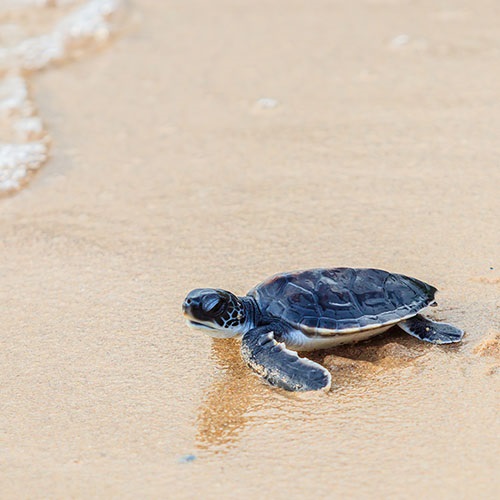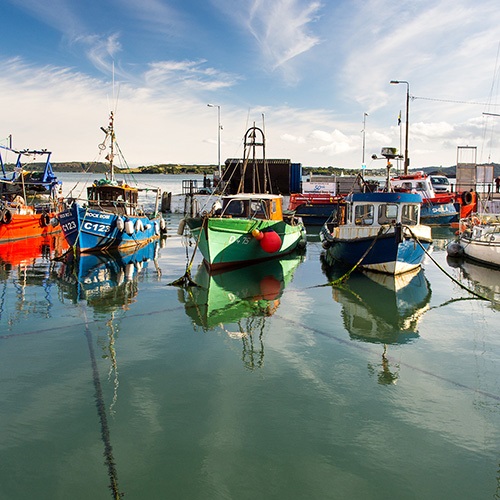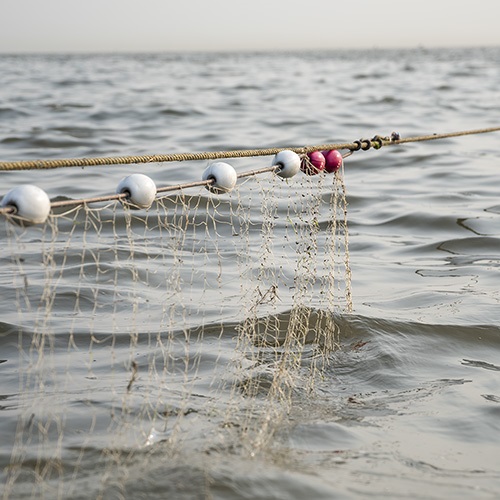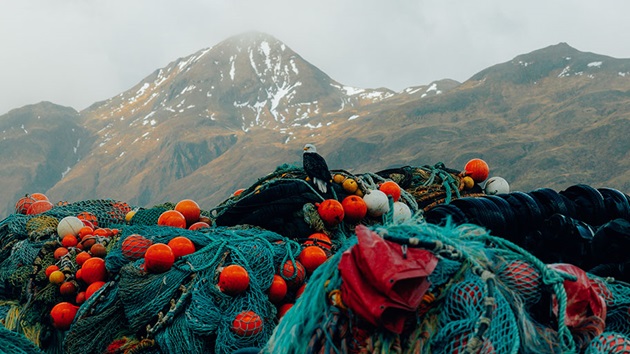Ghost fishing occurs when lost or abandoned gear continues to catch or entangle marine life. It can have devastating consequences on the marine environment.
How does fishing gear get lost at sea?
A recent survey of over 450 fishers found that environmental factors such as bad weather, tides and strong currents were the most common cause of gear loss, followed by interactions with wildlife.
Gears such as trawl nets and lines can get caught on the seabed, and pots and gill nets risk being disturbed by marine traffic and other fishing gear.
While many fishers work hard to reduce gear loss, it can also occur due to poor management at sea or onboard a vessel, or deliberate abandonment.
What are the impacts of lost gear and ghost fishing?
Lost or abandoned nets can drift and entangle marine species or sink to the seabed where they can smother or destroy habitats. Washed up nets put shorebirds and other coastal species at risk of entanglement.
Abandoned pots on the seabed can start a cycle of ghost fishing, where trapped species attract scavengers that also get trapped. Large marine mammals may become entangled in the ropes that connect pots or traps to buoys floating on the surface.
The unselective capture of marine species by ghost gear also harms efforts to fish sustainably, reducing population size without contributing to food production or livelihoods.
Up to 2.5% of all fishing gear is lost annually
>78,000 km
Nets
>25 million
Pots and traps
>740,000 km
Longlines
How does lost gear contribute to plastic pollution?
Defining the amount of the plastic in the oceans is a challenge, however research has estimated that 10 -20% comes from lost or abandoned fishing gear and vessels. The concentration of lost gear is even higher in some regions, such as the North Pacific, where fishing nets account for 46% of all plastic observed.
Studies estimate that up to 2.5% of all fishing gear is lost annually, including over 78,000 km2 of nets, more than 25 million pots and traps and 740,000 km of longlines.
The breakdown of ocean plastic - including plastic fishing gear - can impact the health of marine organisms and ecosystems. Marine plastics are thought to transport invasive species and diseases across the ocean.
How can fisheries prevent gear loss?
Some gear types have a higher risk of loss than others, with static gears such as gill nets, pots and traps, and fish aggregating devices (FADs) the most likely to be lost.
Loss of pots and gill nets can be reduced by retrieving catch quickly and limiting the amount of time they are left underwater (‘soak time’). GPS mapping can also be used to avoid setting gear in areas with high risk of interaction with other vessels and mobile fishing gears.
Marking fishing gear to establish ownership is another effective preventative measure and incentivises the retrieval of lost gear. Identification can reduce gear conflict within or between fleets and helps identify illegal, unreported and unregulated fishing activities.
Good fisheries management is also key to preventing gear loss. This includes adequate on-board storage and crew trained to handle gear correctly and understand the impacts of ghost fishing.
Fisheries preventing plastic pollution
How can the impact of ghost fishing be reduced?
Eliminating all gear loss can be difficult, however fishers can take measures to reduce its impact.
A key way to reduce the impact of gear loss is through gear modification. This includes adding escape hatches and biodegradable panels to pots and traps.
Other modifications can reduce the risk of entanglements between marine mammals and pots and traps, such as using weakened ropes to connect gear on the seabed to marker buoys on the surface. This allows whales to break free more easily. Ropeless technology is also being trialled - this involves using a trigger or timer to bring pots to the surface on demand, avoiding the use of ropes altogether.
The impact of lost FADs can be reduced by using biodegradable materials such as bamboo, balsa wood, and hemp fibres. FADs can also be constructed without netting (a non-entangling design), which reduces capture of species such as sharks and turtles.
Retrieving lost gear and disposing of it safely is also crucial. Many ports provide waste facilities for fishing gear, which can then be recycled.
The MSC requirements for ghost gear
Fisheries certified to the MSC Fisheries Standard should minimise gear loss and must know the impact any lost gear could have on habitats and ecosystems.
In May 2023, a new version of the MSC Fisheries Standard came into effect. It includes strengthened requirements to ensure the impacts of ghost gear are explicitly considered during every fishery assessment.
Fisheries must also have effective measures in place to minimise gear loss and mitigate the impact of any lost gear. These requirements now apply to FADs: fisheries now need to account for any lost FADs and demonstrate how they avoid and manage losses.
Developing our requirements
Find out how we strengthened our requirements on ghost gear management, including a review of global best practice, impact assessments, stakeholder consultation.
The new MSC requirements to improve ghost gear management
Latest global efforts
The Global Ghost Gear Initiative is the first global program established to define best practice in ghost gear management and develop solutions. In 2021, the organisation published guidelines to support fisheries and other stakeholders to implement preventative measures and reduce the impact of lost gear.
MSC certified fisheries
Many MSC certified fisheries have worked hard to manage and reduce the risk of ghost gear.
When the Alaska Pacific cod fisheries became MSC certified, they were required to monitor gear loss to maintain their certification. They also assessed the impacts of lost gear - long lines, pots and trawl nets - on ecosystems. Cod fishing pots in these fisheries have biodegradable escape panels and escape rings to minimise ghost fishing.
In the MSC certified Normandy and Jersey lobster fisheries, all pots are tagged with boat registration and year. Fishers must report lost pots and only a limited number of replacement tags are available. This system motivates fishers not to lose their pots.
The Echebastar Indian Ocean purse seine skipjack fishery received support from the MSC’s Ocean Stewardship Fund to improve the sustainability of operations using FADs in the Indian Ocean. The project will investigate the impact of lost FADs on corals and will support the FAD Watch initiative to intercept lost FADs in the Seychelles.
The Decision: A tuna fishery’s quest for sustainability
Find out more

Endangered, threatened and protected species
The MSC ensures that certified fisheries allow the recovery of any Endangered, Threatened and Protected species.

Improving fisheries management
The MSC seeks to reward best practice in fisheries management and to support fisheries that are working to improve their management systems.

Maintaining fish stocks
Sustainable fish stocks are at the heart of the MSC program. Ensuring that the world’s fish stocks remain healthy is vital for marine ecosystems and global food security.


